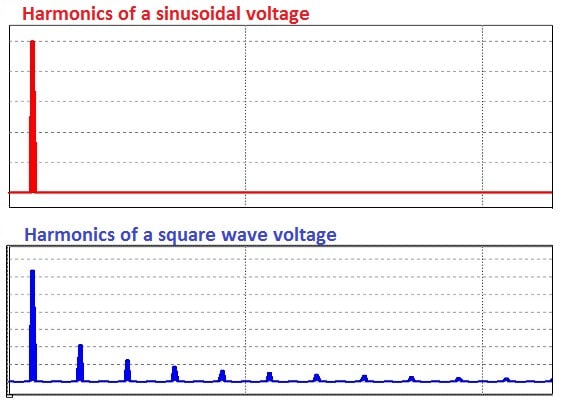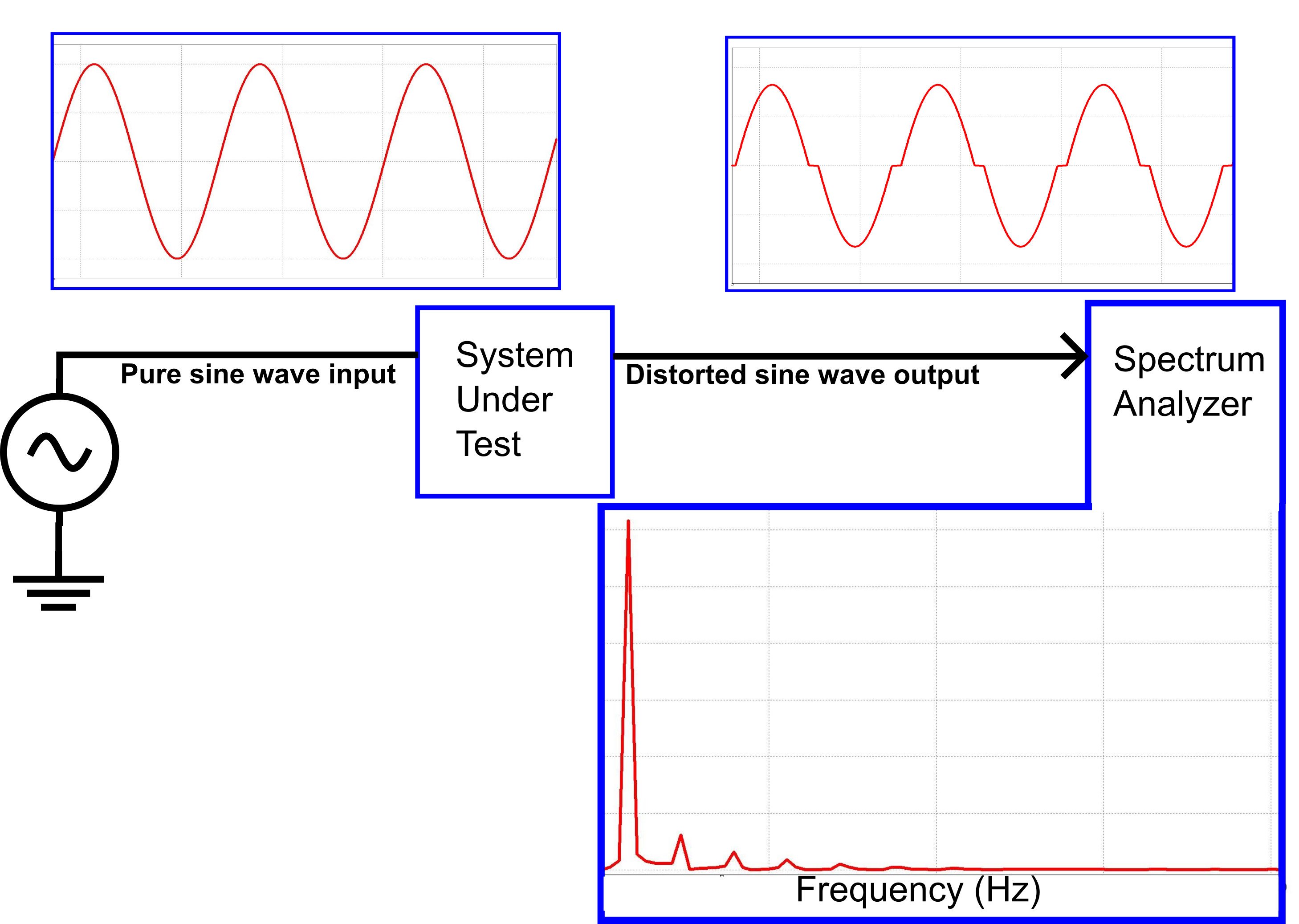Total harmonic distortion (THD) is
a measurement that tells you how much of the distortion of a voltage or
current is due to harmonics in the signal. THD is an important aspect
in audio, communications, and power systems and should typically, but
not always, be as low as possible.
Introduction
Harmonics or harmonic frequencies of a periodic voltage or current are frequency components in the signal that are at integer multiples of the frequency of the main signal. This is the basic outcome that Fourier analysis of a periodic signal shows. Harmonic distortion is the distortion of the signal due to these harmonics.A voltage or current that is purely sinusoidal has no harmonic distortion because it is a signal consisting of a single frequency. A voltage or current that is periodic but not purely sinusoidal will have higher frequency components in it contributing to the harmonic distortion of the signal. In general, the less that a periodic signal looks like a sine wave, the stronger the harmonic components are and the more harmonic distortion it will have.
So, a purely sinusoidal signal has no distortion while a square wave, which is periodic but does not look sinusoidal at all, will have lots of harmonic distortion. In the real world, of course, sinusoidal voltages and currents are not perfectly sinusoidal; some amount of harmonic distortion will be present. Figures 1 and 2 provide visual comparisons, in the time domain and the frequency domain, of a sinusoidal voltage and a square wave voltage.


Figure 1. A sinusoidal voltage and a square wave voltage in the time domain.

Figure 2. A sinusoidal voltage and a square wave voltage in the frequency domain; only the square wave has peaks at the harmonic frequencies.
It is easy to see the harmonic distortion when examining the time domain and frequency domain representations of a square wave, but it is also important to be able to quantify harmonic distortion. The next section shows how to do that with the metric of total harmonic distortion.
Calculating Total Harmonic Distortion
THD is defined as the ratio of the equivalent root mean square (RMS) voltage of all the harmonic frequencies (from the 2nd harmonic on) over the RMS voltage of the fundamental frequency (the fundamental frequency is the main frequency of the signal, i.e., the frequency that you would identify if examining the signal with an oscilloscope). Equation 1 shows the mathematical definition of THD (note that voltage is used in this equation, but current could be used instead):
Equation 1
- is the RMS voltage of the fundamental frequency
Since the amplitudes of the harmonics are needed to calculate the THD, Fourier analysis can be used to help determine THD. To see this application of Fourier analysis, let’s look at the simple example of a 50% duty cycle square wave. The Fourier series representation of a 50% duty cycle square wave is the following:
Equation 2
Equation 3
The expanded form is useful to look at because it highlights the peak voltage (Vpk) of each frequency component, and the THD can be calculated by determining the RMS value (i.e.,
) of each frequency component and plugging them all in to Equation 1:
Equation 4
component. This component can be factored out, and since it appears in both the numerator and denominator, it actually cancels out, which leaves the expression for THD of a square wave as follows:
Equation 5
To calculate the THD from this expression requires a tricky little bit of mathematics. If the summation under the square root in Equation 5 started at n=1, then it would be a convergent series that adds up to
:
Equation 6
is the value of
Equation 7
Equation 8
Measuring Total Harmonic Distortion
Calculating theoretical THD can be a good exercise, but it can be a lot of work, and in practice, you aren’t going to get an ideal signal (e.g., a perfect square wave) anyway. The outcome of these calculations can therefore only give an approximation for the THD that you might get for a given signal type. In practice, THD must be measured to obtain the RMS value of the fundamental frequency and all of the harmonics. This measurement can be done in a couple of ways.In the first method, filters can be used to split the signal into two parts: a signal with all of the harmonics filtered out leaving just the fundamental frequency, and a signal with the fundamental frequency filtered out leaving all of the harmonics. Then the RMS value of each of those two parts can be measured and the THD calculated:
The second method for measuring THD is to measure the amplitude of the fundamental frequency and each harmonic and then use those measurements to calculate THD using Equation 1. This measurement can easily be done using a spectrum analyzer or a THD analyzer which will execute Equation 1 automatically. An alternative measurement technique is to capture voltage or current data and then perform a Fourier transform on the data collected. The example below outlines how this second method is used.
Example THD Measurement
The example block diagram in figure 3 shows a 1 kHz sine wave passing through an amplifier to create a new 1kHz sine wave that has some crossover distortion. This new wave is fed in to a spectrum analyzer which gives a graphical display of the amplitude of a number of the harmonics.
Figure 3. A system that introduces crossover distortion into a signal.
Zooming in on the frequency spectrum of the distorted sine wave output, we can see the amplitudes at several of the harmonic frequencies:

Figure 4. Frequency spectrum of sinusoidal voltage with crossover distortion.
From this frequency spectrum, I manually measured the amplitude of each of the harmonic frequencies and recorded the data in the table below:
| Harmonic | Amplitude |
| 1 | 3.08V |
| 3 | 0.308V |
| 5 | 0.159V |
| 7 | 0.090V |
| 9 | 0.0487V |
| 11 | 0.0253V |
| 13 | 0.0164V |
| 15 | 0.010V |
The amplitudes of even-numbered harmonics and harmonics above the 15th are nearly 0, so I didn’t include them in my calculation.
The measured amplitudes are plugged in to the THD equation:
and since the
This calculation gives a THD of 0.118 or 11.8%.
Of course a THD analyzer would automate the process of calculating THD from the amplitudes of the harmonics. Using a THD analyzer for this signal gives a value of 11.9%, which confirms the accuracy of the manual method that I just went through.
Final Words
This article has provided some background about THD and how to determine it, both theoretically and in a real (simulated) system. But it has not discussed the kinds of systems where THD is an important measurement.THD is important in several types of systems, including power systems, where a low THD means higher power factor, lower peak currents, and higher efficiency; audio systems, where low THD means that the audio signal is a more faithful reproduction of the original recording; and communication systems, where low THD means less interference with other devices and higher transmit power for the signal of interest.
Look for future articles where I will go into more detail about these specific types of systems.






No comments:
Post a Comment